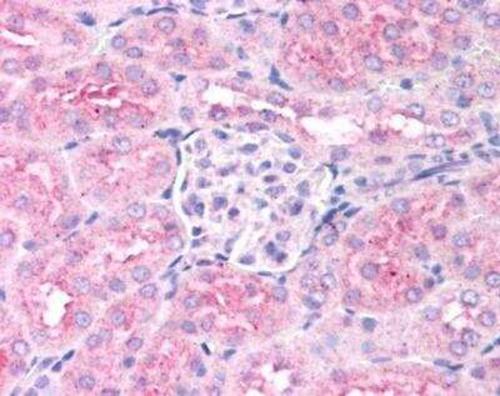EGLN1 Rabbit Polyclonal Antibody
Frequently bought together (2)
Transient overexpression lysate of egl nine homolog 1 (C. elegans) (EGLN1)
USD 605.00
Other products for "EGLN1"
Specifications
| Product Data | |
| Applications | IHC, WB |
| Recommended Dilution | Immunohistochemistry-Paraffin: 2.5 - 5.0 ug/mL, Immunoprecipitation: 1:10 - 1:500, Immunocytochemistry/ Immunofluorescence: 1:50 - 1:500, Immunohistochemistry: 2.5 - 5.0 ug/mL, Western Blot: 2 ug/mL, Knockout Validated, Knockdown Validated |
| Reactivities | Human, Mouse |
| Host | Rabbit |
| Clonality | Polyclonal |
| Immunogen | A synthetic peptide made to an internal portion of mouse PHD2/HIF Prolyl Hydroxylase 2 (between residues 300-400). [UniProt# Q91YE3] |
| Formulation | Tris-citrate/phosphate, pH 7, 0.1% Sodium azide. Store at 4C. Do not freeze. |
| Concentration | lot specific |
| Purification | Immunogen affinity purified |
| Conjugation | Unconjugated |
| Storage | Store at -20°C as received. |
| Stability | Stable for 12 months from date of receipt. |
| Predicted Protein Size | 43 kDa |
| Gene Name | egl-9 family hypoxia inducible factor 1 |
| Database Link | |
| Background | HIF prolyl 4-hydroxylases (PHDs) are proyl hydroxylase domain-containing enzymes (PHD1/ Egln2, PHD2/ Egln1, PHD3/ Egln3, and P4H-TM) that mediate important physiological responses to hypoxia by modulating HIF1alpha levels. The HIF-alpha is regulated by hydroxylation, both by a family of PHDs leading to ubiquitination and proteasomal degradation, and by transcriptional inactivation following asparaginyl hydroxylation by FIH (factor inhibiting HIF). Under normoxic conditions, HIF Prolyl Hydroxylase 2 (HIF1-PH; also called PHD1 or Egln2) catalyzes the post-translational formation of 4-hydroxyproline through hydroxylation of a specific proline found in each of NODD/CODD domains of HIF1A and also hydroxylates HIF2A with preference for CODD site of HIF1A/HIF1B. After hydroxylation, HIFs undergo proteasomal degradation via VHL (von Hippel-Lindau) ubiquitination complex. However, under hypoxic conditions, the hydroxylation reaction is tempered which allows HIFs to escape degradation process followed by their nuclear translocation, heterodimerization with HIF1B, and increased expression of hypoxia-inducible genes. HIF1-PH, through regulating HIF1 stability, is involved in various hypoxia-influenced processes such as angiogenesis in retinal/cardiac functionality as well as tumor angiogenesis, and defecticve EGLN1 have been linked to ECYT3 (familial erythrocytosis type 3). |
| Synonyms | C1orf12; ECYT3; HALAH; HIF-PH2; HIFPH2; HPH-2; HPH2; PHD2; SM20; ZMYND6 |
| Note | This HIF Prolyl Hydroxylase 2 antibody is useful for Western blot, Immunocytochemistry/Immunofluorescence, Immunohistochemistry-Paraffin embedded sections and Immunoprecipitation. In Western blot a band is seen ~43 kDa representing HIF Prolyl Hydroxylase 2. There is also a non-specific band of similar intensity at ~75 kDa. |
| Reference Data | |
| Protein Pathways | Pathways in cancer, Renal cell carcinoma |
Documents
| Product Manuals |
| FAQs |
| SDS |
{0} Product Review(s)
0 Product Review(s)
Submit review
Be the first one to submit a review
Product Citations
*Delivery time may vary from web posted schedule. Occasional delays may occur due to unforeseen
complexities in the preparation of your product. International customers may expect an additional 1-2 weeks
in shipping.






























































































































































































































































 Germany
Germany
 Japan
Japan
 United Kingdom
United Kingdom
 China
China






